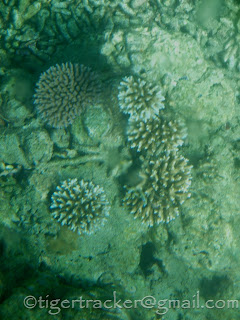The tourist guide, the dunghy wallah, the resort manager and everyone on Andaman swear you dont need to know swimming that I'm left wondering. True, if youv'e travelled more than a 1000 kilometers across the sea and did not risk your life to peer underwater, all the money you spent is wasted. Then if you are like me and were a little reluctant about experimenting with rusty skills there had to be a way out. The solution was the Glass Bottomed Boat!
Both in Elephant beach and Wandoor you have enterprising boatmen with this craft; a boat with an outboard motor and the center of the floor replaced by glass a few inches thick. You sit on either side with your knees knocking on the the fellow traveler's knee sitting across you and peer down at a world that is magical.
 A few hundred feet off the beach the land dips down suddenly into the coral bed. The edge of the reef is where all the action takes place. Most of the coral is broken and dead after the tsunami but is regenerating slowly.
A few hundred feet off the beach the land dips down suddenly into the coral bed. The edge of the reef is where all the action takes place. Most of the coral is broken and dead after the tsunami but is regenerating slowly.The view through the glass is not 'photo quality' but it gives a fair idea of a world far removed from ours.

I was a bit disappointed with the colours that I saw but then I realized that the glass itself had a blue tint to it and the sunlight never really was hitting in the right angles. There would be moments of sudden brightness and colour with large intervals of monotone. Fish of all sizes and colours would pass under your wondering gaze. Before you could identify one another interesting shape would glide by. The boat was going around in circles and before the camera could focus through the water we would be over another part of the reef.
It was then I realized the value of learning to swim. Snorkeling and scuba diving will take you closer to the scene of action but a fundamental knowledge of swimming would make things more interesting. There were folks 'snorkeling' with a life jacket on but that was just floating on the surface. You need to learn to swim to get close to the action.
There is one other place to get close to the action. The tide pools. If you are willing to wade thigh deep and stand immobile at a place you could have the action at your feet. Of course, if you are a Canonian or Nikonian you'd be reluctant to carry your gear though. As for me. I'm an Oly fan and my E3 has no fear of water! See what I got for my effort.
The secret is is stand absolutely still. Even a small movement will create ripples on the water surface and your focusing will struggle and it goes without saying every fish within the next few meters around you will scatter for the nearest cover. My patience was tested but the prize catch came late in the day as I was about to wind up.
CATFISH
Less than a meter from my legs, from under a rock a school of catfish peered out cautiously. Slowly, and reluctantly they ventured out to perhaps swim out further. I tried bending slowly to get a close up but that was the last I saw of them. Light was fading and I had to go but my actions had one spectator. He was looking for his meal and now he knew where to hunt!















































